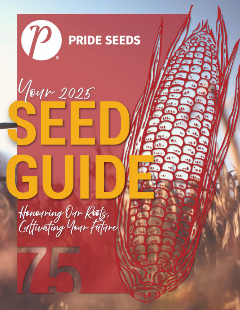Browse our selection of products below
___________________________________________________________________________________________________________________________________________

2024-2025 PRIDE Seeds Product GuideYou can find all of our products on the website, including supporting performance data and create your own personalized guide called My Guide. You can also download the digital version of our printed product guide which includes product comparison charts. |
Enhance your knowledge and stay ahead with PRIDE SEEDS Corn and Soybean School videos.
SHOP THE PRIDE SEEDS E-STORE
-7.png?sfvrsn=87920db3_3)
STAY UP-TO-DATE WITH PRIDE SEEDS LATEST BLOGS, NEWS AND ARTICLES
Corn Maturity - Helpful Tips
As we write this article, it's the third week of July and many corn fields in the London to Niagara corridor have fully emerged corn tassels, or are very close to that point. This is now the fun time of year for Corn Agronomists and Corn Growers, where we can watch our fields and chosen hybrids progress toward maturity in September. For us, this is the part of the growing season where detailed learning about our products takes place.
In this article we hope to provide some insight into grain corn progression towards maturity, and an understanding of the growth stages after tasseling/silking and pollination.
Corn essentially lives two half-lives, the first being the Vegetative Stages (V1-VT), which under average growing conditions lasts about 65 days. When the VT stage (tassel emergence) is reached, the plant enters its second half-life, which coincidentally also lasts about 65 days or longer, depending on late season growing conditions.
The Reproductive Stages (R1 - R6) are as follows
- R1 - Silking (Pollination): generally lasts about 11 days
- R2 - Brown Silking/White Blister: the end of the pollination period (8 days)
- R3 - Milk Stage: where kernels start turn yellow and are filled with a milky white fluid (8 days)
- R4 - Dough Stage: kernel milk becomes pasty due to rapid starch accumulation (12 days)
- R5 - Dent Stage: almost all kernels are dented (27 days). Distinct 'Milk-Line' becomes visible
- R6 - Physiological Maturity: black layer
*intervals are a guideline only, and can vary by hybrid and current weather conditions
Knowledge of these distinctly separate reproductive stages, and their time intervals, provides an extremely important foundation for evaluating corn hybrids for true Relative Maturity (RM) or CHU Rating, and also for their adaptability to individual farm scenarios. With these stages in mind, growers can track grain progression in their own fields to measure a hybrid's true fit on their farm, and also compare competitor hybrids for maturity differences.
Two helpful hints:
- All grain progression occurs from the butt of the ear, towards the tip
- Of all these stages, the R5 Dent Stage is the most common window for making maturity assessments
During the dent stages, kernel milk-line will be readily visible by breaking off the top half of the ear and looking at the side exposure of the kernels. The milk-line indicates the barrier between hard starch dry matter accumulation (above ML) and the remaining milk/dough (below ML).
We are all familiar, or should be, with the milk-line progression from first dent through ¾ milk-line, ½ milk-line, and ¼ milk-line. Conveniently, these four intervals occur during the four-week dent process. Therefore in simple terms, the grain requires approximately one week under seasonal weather conditions to advance in each stage of milk-line progression. From here, hybrids can be compared.
Maturity evaluation can be done during any growing season, but when does it really matter to us as growers? Certainly in short growing seasons - due to either late planting or a lack of Heat Unit Accumulation, or both - this method can be used to evaluate whether hybrids will make it to natural physiological maturity/black layer without being shut down by a killing frost.
This is also a great tool for evaluating new corn hybrids on your farm. Every hybrid comes with a maturity rating established by the supplier, but when it comes to being in your fields for the first time, this method can be used to evaluate adaptability of new genetics to the specific needs of your individual farming operation.
It's always a very satisfying feeling when your corn crop reaches natural maturity, and black layers. Dry matter accumulation in the kernel is complete, and the grain is safe from frost damage. Kernel moisture will range at this stage from 32 to 35%. This stage is also a good time to evaluate hybrid maturity fit for your farm.
TAKE PRIDE IN YOUR INBOX
Expert advice, news and information
THE PRIDE SEEDS ADVANTAGE
Farming is one of the most demanding industries in the world, subject to a variety of factors such as time, weather, and global pressures. You know this every time you look out the window and think about the field in front of you. Growers and dealers deserve an advantage: The PRIDE Seed Advantage.
LEARN MORETHE PRIDE SEEDS ADVANTAGE
Every year PRIDE Seeds works hard to produce leading-edge products that enable success where it matters most, on your farm. Our dedicated team strives to provide sales expertise, agronomy support, quality production, and service tailored to meet your needs.
LEARN MORE

Leave a commentOrder by
Newest on top Oldest on top